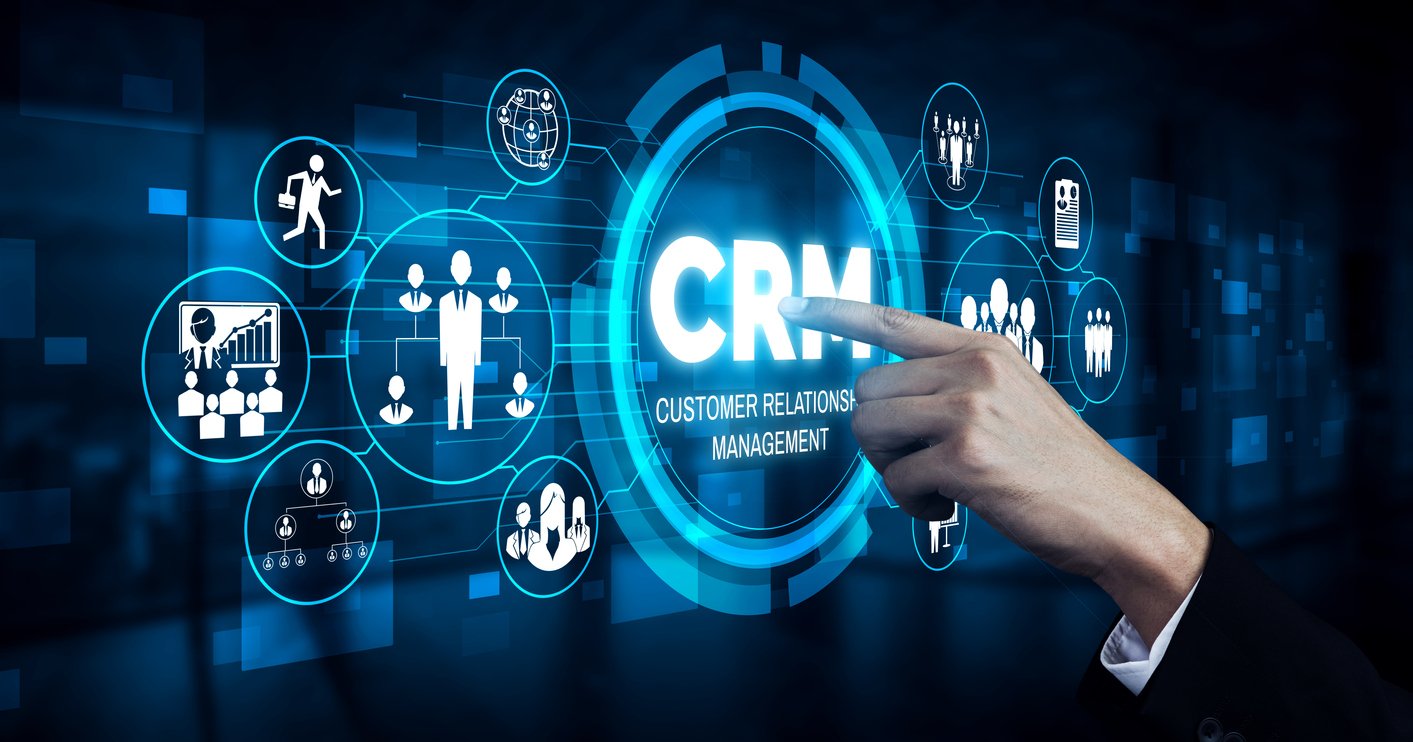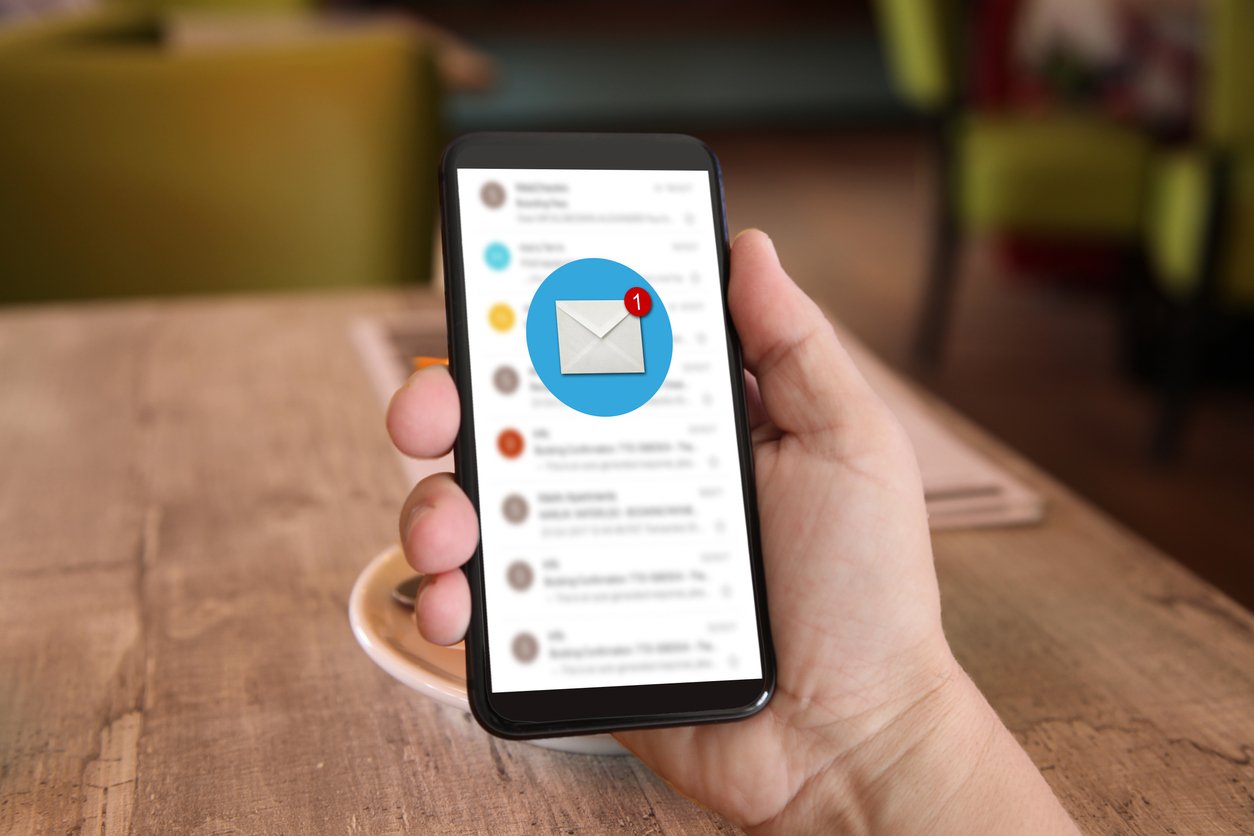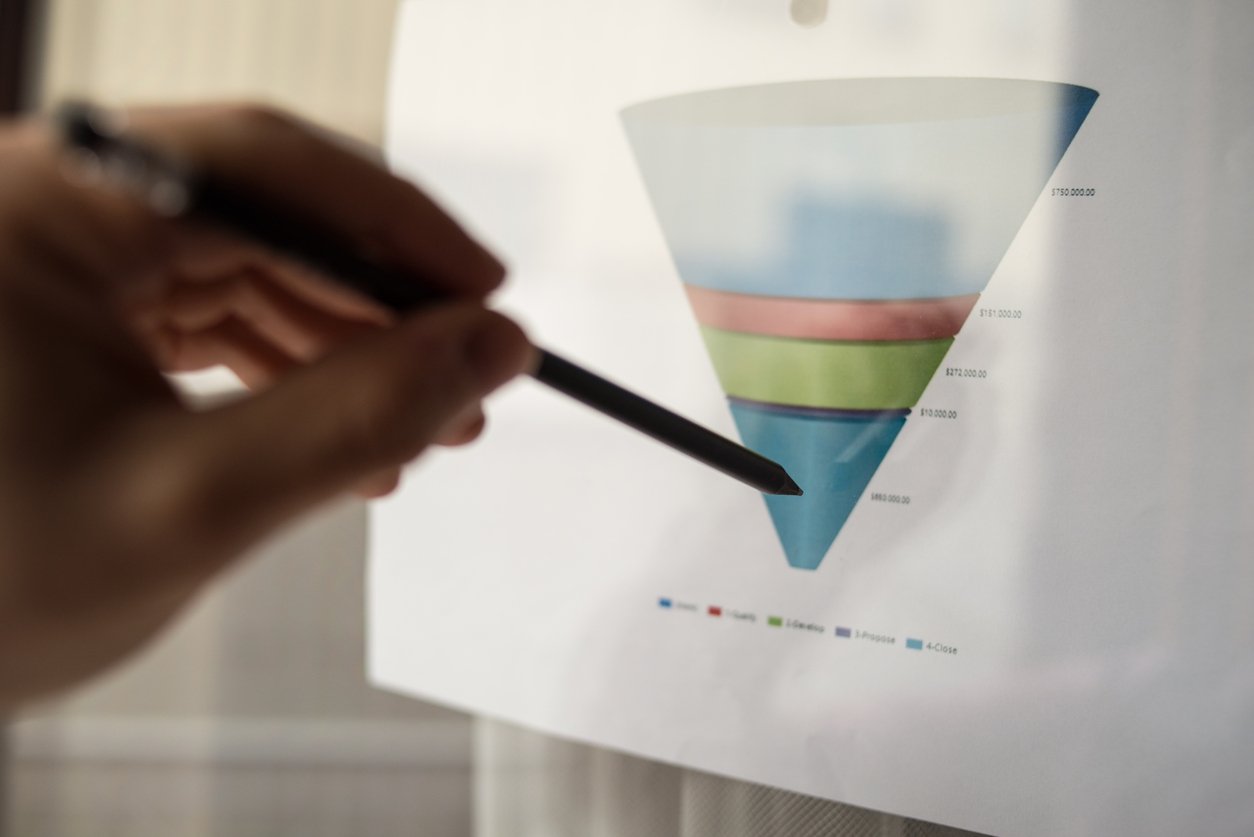
6 Strategic Sales Plan Examples [Pro Tips Included]
 Updated on
Updated on
 By Bradley Kovacs
By Bradley Kovacs
Bradley Kovacs
Bradley has been passionate about technology since childhood, starting with Microsoft Flight Simulator at age six. In college, he automated his data e...
learn more
Bradley Kovacs
Bradley has been passionate about technology since childhood, starting with Microsoft Flight Simulator at age six. In college, he automated his data e...
Table of Contents
Table of Contents
You're in quite the pickle.
You want to create a strategic sales plan for your sales team so you have a set of guidelines and a procedure to reach your sales goals for the end of the year.
But you don't really know where to start.
Or where to end.
Or what it should look like.
Or, if you're being honest with yourself, what should really be in it at all.
Don't worry! We've got you covered with some sales strategy plan examples and pro tips so you'll be developing a dynamite one of your own in no time.
But first, what is a sales strategy plan?
What is a Sales Strategy Plan
A strategic sales plan is a document containing the details of how your organization will reach its sales goals. It should be something of a guide that will lay out expectations for what and how you and other salespeople on your team should be going through the sales process by combining analysis, research, expectations, and your sales process.
If that sounds confusing, don't worry. We'll break it down more.
The most important thing to keep in mind, though, is that a sales strategy plan is made up of several parts to create a plan of attack on reaching sales goals and increasing business revenue. It's your business's how-to guide for sales.
With a strategic sales plan, everyone on your sales team should be on the same page. Everyone will know what their expectations are and how to reach them. And everyone will know the overall sales goals for the company.
Your sales plan and strategy will make that clear.
4 Types of Strategic Sales Plans
When talking about types of sales strategy plans, you're most likely to see inbound and outbound sales plans discussed.
However, we're going to add 2 more into the mix:
- B2B Strategic Sales Plans
- B2C Strategic Sales Plans
Inbound Sales Strategy Plans
The idea behind inbound sales is that the prospect reaches out to you about your product(s) or service(s), rather than the other way around. An inbound sales strategy plan is the map you use to make that happen. This typically involves creating content that targets and will be seen by your target audience.
Inbound sales strategies can include:
- Digital web ads
- Social media
- Blog posts
- Optimizing SEO
- Referrals
A lot of these strategies overlap with marketing strategies because really these two things work in tandem.
Outbound Sales Strategy Plans
The idea behind outbound sales is for you, as the salesperson, to reach out to a prospect with your product(s) or service(s). In this sales strategy, you're the one doing the research involved to generate leads and contact and qualify them to ensure they're a good fit for your product(s) or service(s).
Outbound sales strategies can include:
- Cold calling or emails
- Lead generation software
- Online research
Inbound vs Outbound Sales Strategy Plans

Inbound and outbound sales have their own benefits associated with them. However, the best leads are found when they're both used together.
|
Inbound Sales |
Outbound Sales |
|
|
Who Initiates Contact |
The prospect |
The salesperson |
|
Target |
Buyer persona/target audience |
Qualified leads |
|
Effectiveness |
59% of marketers believe inbound sales make higher quality leads |
16% of marketers believe outbound sales make higher quality leads |
|
Cost-Efficiency |
Higher set-up costs, more cost-effective long-term |
Less expensive start-up, but with costs accumulating over time |
B2B Strategic Sales Plans
B2B sales stands for business-to-business sales. This means that rather than selling products or services to the general public, a business is selling its products to another business. You can think of wholesale businesses, or package suppliers as examples of B2B businesses. A B2B strategic sales plan is simply the procedure or the means to achieve this end.
B2B sales strategies can include:
- Cold calling or emails
- Lead generation software
- Digital ads
- Social media
- Referrals
- Online research
B2C Strategic Sales Plans
B2C sales stands for business-to-consumer sales. This means that a business is selling its products or services directly to the general public. Retail is a B2C business. So, as you've probably gathered at this point, a B2C strategic sales plan is the plan of attack on how to achieve this end.
B2C sales strategies can include:
- Cold calling or emails
- Lead generation software
- Digital ads
- Social media
- Referrals
- Online research
B2B vs B2C Strategic Sales Plans

Although the target audience differs, there is a lot of overlap between the sales strategies used for B2B sales and B2C sales (depending on whether you're using inbound and/or outbound sales). The differences between selling to individuals vs to companies/organizations come into play more in how the strategies are applied, and how the relationship between you and the customer is shaped. And these differences can involve different skill sets to each other.
|
B2B Sales |
B2C Sales |
|
|
Customer |
Businesses |
Individual customers |
|
Relationship Length |
Longer term (may take longer to reach a decision, and more likely to keep using your products/services long-term) |
Shorter-term (typically takes shorter to make a decision, could become a loyal customer or be a one-off) |
|
Size of Sales |
Larger size of sales necessary to be supplied |
Smaller size sales just to satisfy individual customers |
|
Sales |
159.3 billion GBP in the UK 2019 |
197.1 billion GBP in the UK 2019 |
|
Reasons for Sales |
Product-driven |
Emotion-driven |
How to Write a Sales Strategy
So. Now you know what a strategic plan is. And you know a thing or two about different types of them.
It feels like time to learn a little about how to write one.
A sales strategy takes some work to develop. To create one you'll need to:
- Analyze your organization's sales data from the past: Before deciding where your company wants to go, know where it came from. Research past data, sales goals, strategies, successes, and failures
- Develop sales goals: Use this data to help steer your new sales goals
- Take stock of your current sales process: Perform a SWOT analysis to understand its strengths and weaknesses, how long the process typically takes, what areas have the most success vs where most prospects drop off, etc
- Understand your target demographic: If you don't already have buyer personas, develop them (using the data gathered in previous steps) so that you can understand your target demographic for prospect generation (and for finding and understanding your consumer base)
- Take stock of your sales team: Perform a SWOT analysis to understand the strengths and weaknesses of your own sales team as well. What are different salespeople best at? What could they improve on? Where should their focus in the sales process be? Should it change? Should an opener try out being a closer, etc?
- Take stock of the sales resources and tools currently available to you: Simply take stock of what sales resources and tools you already have, what they're used for, if there's more they can do, etc
- Decide if there's anymore you'd like to get: Are there any sales tools you're missing? Is there a gap in your sales cycle somewhere that a new tool could help fill? You'll have to keep in mind your budget here (you'll need a budget if one hasn't already been developed)
- Use data to decide what strategies work best for your team: Using the data you've already collected, what strategies have you had success with in the past, and what strategies haven't been as successful?
- Be general and be specific: When developing sales goals and sales strategies, it can help to develop higher-level company goals and strategies, and more specific, maybe even team member specific, sales goals and sales strategies.
- Keep your sales strategy responsive: If something's not working, don't be afraid to address it. If something's working really well, take advantage of it.
And there's more where that came from. If you'd like more detail in developing a killer sales plan, you're in luck. Just click through for a breakdown of the 11 steps listed there.
Optimizing Sales Strategy and Planning
A well-defined strategic sales plan is the engine that drives revenue growth. It goes beyond setting quotas and outlines a clear roadmap for achieving your sales goals.
Here's how to optimize your sales strategy and planning:
1. Mapping out the Sales Process from Lead Generation to Closing
The first step is to create a detailed map of your entire sales process. This journey, often referred to as the sales funnel, starts with lead generation - identifying potential customers. Here, you'll define your ideal customer profile (ICP) to target the right audience. Next, qualified leads are nurtured through the funnel with informative content and outreach efforts. This stage often involves sales and marketing alignment to ensure a seamless transition.
As leads become sales-qualified opportunities, your sales reps take center stage. They engage with potential customers, understand their needs, and present your product or service as the ideal solution. Effective communication, negotiation, and clear value propositions are crucial for successful closing.
2. Identifying Bottlenecks and Areas for Improvement
Once you have a clear picture of your sales process, it's time to pinpoint bottlenecks and areas for improvement. This is where a critical analysis comes in. Are there specific stages in the funnel where leads are dropping off? Is your sales cycle longer than it should be?
Strategic sales plans should address these roadblocks. If lead generation is lagging, consider implementing new marketing campaigns or refining your ideal customer profile. If your sales cycle is lengthy, explore ways to streamline it by providing better sales enablement tools or training.
By constantly evaluating your sales funnel and identifying areas for improvement, you can make data-driven decisions that optimize your sales strategy and planning.
3. Implementing Technology and Automation to Streamline Processes
Technology plays a vital role in modern sales. Strategic sales tools can automate repetitive tasks, freeing up your sales reps to focus on high-value activities. This could include automating email sequences, scheduling appointments, or managing customer data.
For instance, CRM software provides a centralized platform for managing all customer interactions. It allows you to track leads, analyze sales data, and gain valuable insights into customer behavior. By leveraging technology, you can streamline your sales process, improve efficiency, and ultimately close more deals.
6 Strategic Sales Plan Examples

There are many variations of sales plans and strategies. When it comes to strategic sales plan examples, it can be helpful to have them broken down into examples of different types of sales strategies, as well as examples/templates for a strategic sales plan.
So that's what we've done.
3 Sales Strategy Examples
There are a variety of different types of sales strategies you can implement using a sales plan strategy. Some of those sales strategies are:
- Drip campaigns
- Cold calling campaigns
- In-person or video conference meetings and demonstrations
Drip Campaigns
A drip campaign is a series of scheduled messages to a specific segment of your prospects to coax them into making a purchase. Drip campaigns allow you to set up automated emails for you to schedule and then leave while you continue using other sales strategies to try and sell.
Check out the table below outlining different types of drip campaigns, what it's for, and who they'll target.
|
Type of Drip Campaign |
Purpose |
Target |
|
Welcome |
Welcome new customers (or new potential customers) by introducing your brand, updating them on any new brand info or deals, sharing your bestsellers or best resources, offering discounts or free trials, etc |
New subscribers/members/purchasers |
|
Nurture |
Persuade a cold lead that your products would be a good fit for the business and establish trust between you (so be upfront about what you want from this lead, but don't be too pushy. Honesty not aggressiveness is a good policy here). Messages should be on-brand for your business's voice, but should also be enjoyable/interesting for the prospect to read. |
New (cold) leads |
|
Abandoned Cart |
Remind customers that they left unpurchased items in their carts (and gently nudge them to purchase them). Again make sure you follow your brand voice. |
Those who didn't follow through with a purchase (or abandoned their carts) |
If you want to learn more about drip campaigns, make sure you check out our other articles on the subject, including The Ultimate Guide to Drip Campaigns (the above info is a summarized version of this article), 6 Drip Email Campaign Examples That Guarantee Results, and Drip CRM Explained.
Cold Calling Campaigns
Cold calling is when you call potential prospects who, as far as you know, have no experience or really even knowledge of your business, and you try to convince them to move forward in the sales process with you. Maybe that means the person on the other end of the line connects you with a key decision-maker. Maybe it means you'll schedule a meeting.
What is Cold-Calling provides these tips for cold-callers:
- Embrace rejection
- Use technological and digital tools
- Improvise
- Develop a schedule
- Be good at leaving voicemails
For more tips and tricks (and examples and templates) on cold calling, check out our article Cold Call Script.
In-Person or Video Conference Meetings and Demonstrations
Virtual selling is becoming more and more popular, especially with the push to work from home due to the COVID-19 pandemic.
But whether it's digitally or in-person, meeting with your prospects can be a great strategy.
With a meeting, you're able to demonstrate your product for your prospects more clearly, and better able to gauge their reactions based on visual cues.
63% of leaders in sales say, according to HubSpot (citing its own report), that virtual meetings and in-person meetings are at least as effective as each other.
This just goes to show that the move to virtual sales doesn't remove the effectiveness or importance of meetings as a strategy.
Video conferencing technology like Zoom, Google Meet, or Microsoft Teams can be used to host virtual meetings so you can see each other, and access a chat which can be useful for sending links or documents to your prospects.
However, each platform has its own limitations depending on the plans you purchase.
3 Strategic Sales Plan Examples/Templates
Now moving on to some strategic sales plan examples/templates.
The first strategic sales plan template isn't actually a strategic sales plan template, but a strategic business plan template from HubSpot that can be modified to be for sales.
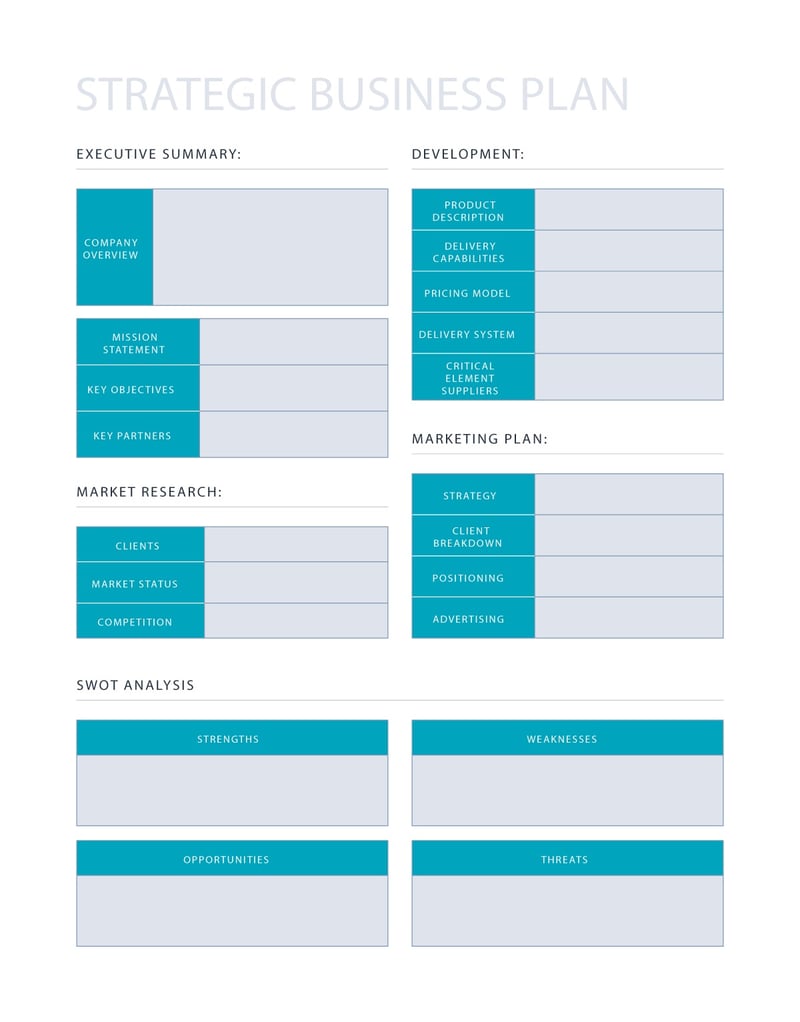
The template can be downloaded after submitting the requested information.
Next, we have two downloadable, free strategic sales plan examples (templates) from Smartsheet. Again, neither is directed exactly at sales, but both can be altered to be that way.
The first is a One-Page Strategic Planning Template:
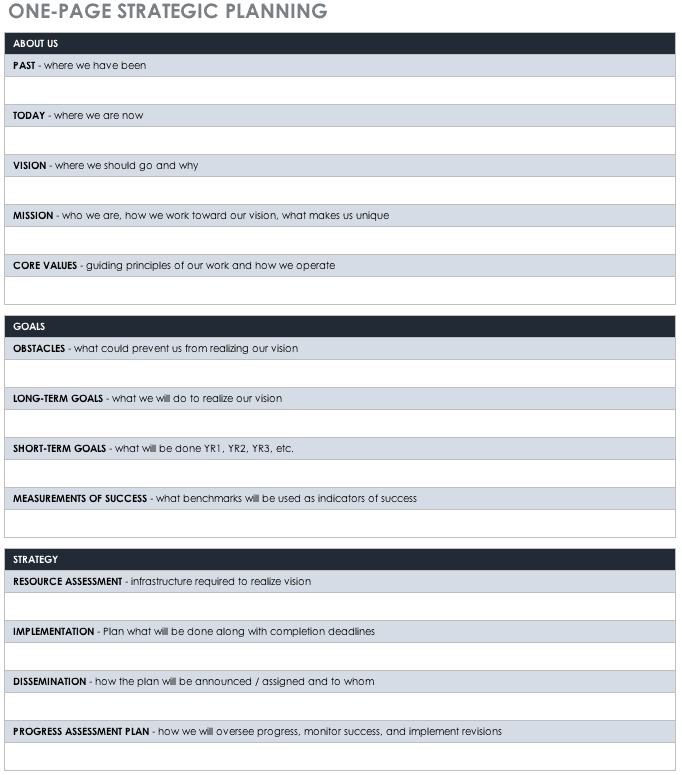
The second is a Strategic Marketing Plan Template:
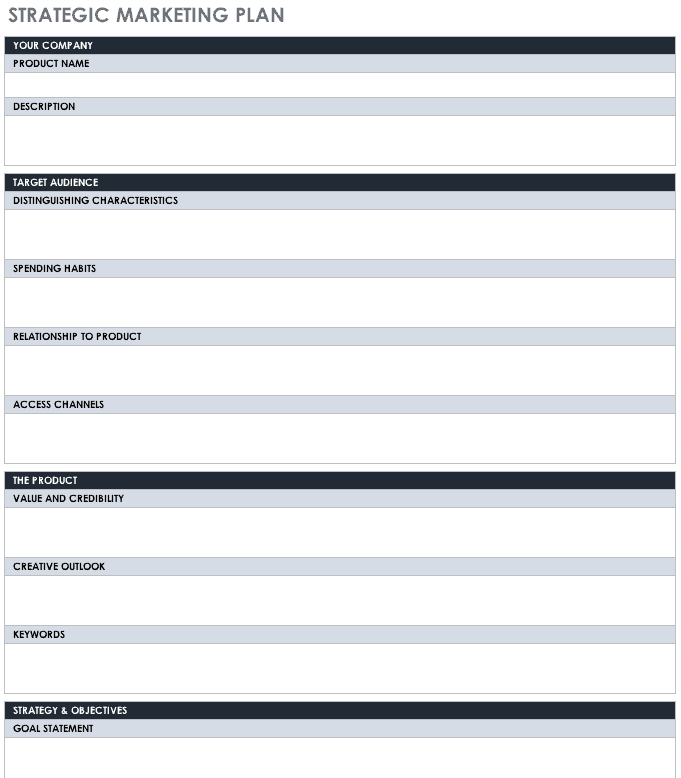
Both of these templates have an added disclaimer (pictured below) when you download them.

Source: Downloaded One-Page Strategic Planning Template
5 Strategic Sales Plan Pro Tips
Developing a strategic sales plan is an arduous task. Ensuring it works isn't necessarily easier. Luckily, we've rounded up some strategic sales plan pro tips for you.
Some of those tips are:
- Know your market position
- Keep your sales process in mind
- Adopt a sales CRM if you don't already have one
- Track the data available to you
- Don't be afraid to make adjustments
Know Your Market Position
To develop achievable goals, you want to know the market position of your industry and to create clever sales strategies, you'll need to know your business's specific market position.
What is the quality (or qualities) your business has that draws customers to it? Why should they choose your business over other competitors? What do you have that they don't? Or what don't you have that they do?
If you're not entirely sure, this may be something to collaborate with the marketing team on discovering, because it's very important to how you both pitch yourselves to potential customers.
Ultimately, your unique market position is what you'll be able to leverage in not only your sales strategy but sales on a one-to-one level, too.
Remember Your Sales Process
You already have a sales process. Keep it in mind when you're developing your sales strategy plan.
Even if your sales process isn't as effective as you'd like it to be, don't create a sales plan that will involve an entire overhaul of your sales process all at once. It'll be an inefficient way to introduce change to your team – it will just be too much at once. Sales may completely halt while everyone adjusts to the new way of selling.
So instead keep your sales process in mind when creating your strategic sales plan. If it'll need to be adjusted, create sales goals over time to increase its efficiency and have them built right into your sales strategy plan.
Adopt a Sales CRM
If you haven't adopted one already, you're already behind.
A sales CRM makes every aspect of the sales cycle easier. It helps manage and generate leads, keep track of data, and automate emails … CRMS like Ringy even allow you to call directly from the CRM, where the call will be logged and recorded.
CRMs are an invaluable tool for creating a more efficient sales process. You'll be able to increase the time your sales team spends selling rather than doing other administrative tasks.
(Which psst, most inside salespeople only spend a third of their time actually selling.)
Track Your Data
Another reason to adopt a CRM, make sure you're tracking your sales data. You'll want to analyze the progress of your strategic sales plan. Is it working? Are your salespeople struggling with it? Are sales goals being hit on time?
These are all the types of things you'll want to watch out for. Because if you don't know how well your sales strategy plan is working, you won't know if you've developed a good plan. Not only is this important for the company's sales success for the quarter, year, etc, but it affects how well you'll be able to develop strategic sales plans in the future, too.
Make Adjustments
All that being said, also keep in mind that a sales strategy plan doesn't have to be a static document. You can be making adjustments to it, and your sales process, as you go and realize what is and isn't working. Just make sure you're keeping your team updated on any changes.
And, as mentioned previously, just make sure you aren't introducing too many changes all at once.
But just like your sales process is an ever-evolving process, your sales strategy will also be ever-evolving. As new tools are introduced, A/B testing is done, goals are or aren't hit, you'll discover new and better ways of doing things. These things can be reflected in your plan. You want the business to be as successful as possible, and having a responsive plan that steers the sales ship is part of that.
Leveraging Technology and Tools to Assist With the Sales Strategy Plan Process
Strategic sales plan examples involve leveraging technology and tools to assist you with the sales strategy plan process.
Here's how to leverage technology throughout your sales strategy and planning process:
1. Utilizing CRM Software for Customer Relationship Management
A robust CRM system is the backbone of any modern sales organization. CRM software helps you manage all your customer interactions in one centralized location. This includes storing contact information, tracking lead activity, and managing sales opportunities.
Here's how CRM software supports your strategic sales plan:
- Improved Lead Management: CRM allows you to effectively nurture leads through the sales funnel. You can track lead interactions, assign tasks, and measure the effectiveness of your marketing campaigns.
- Enhanced Sales Forecasting: CRM data provides valuable insights into sales pipelines and deal stages. This allows you to forecast sales performance more accurately and make informed decisions about resource allocation.
- Stronger Customer Relationships: By tracking communication history and preferences in the CRM, you can personalize interactions and provide exceptional customer service.
2. Incorporating Sales Analytics Tools for Data-Driven Decision-Making
Intuition is a valuable asset in sales, but data should be your guiding light. Sales analytics tools provide a wealth of information about sales performance. They track key metrics such as lead conversion rates, sales cycle length, and customer lifetime value.
Here's how sales analytics tools can inform your strategic sales plan:
- Identify Sales Trends: By analyzing historical data, you can identify trends and patterns in your sales performance. This allows you to spot areas for improvement and capitalize on successful strategies.
- Optimize Sales Resources: Sales analytics can help you understand which marketing channels and sales tactics are most effective. This allows you to allocate resources more efficiently and focus on activities that generate the greatest return on investment (ROI).
- Predict Customer Behavior: Sales analytics tools can help you identify buying signals and predict customer behavior. This allows you to personalize your sales approach and close deals more effectively.
3. Integrating Sales Enablement Platforms to Empower Sales Teams
Equipping your sales reps with the right tools and resources is crucial for success. Sales enablement platforms provide a comprehensive suite of content, training materials, and sales collateral, allowing your reps to be more knowledgeable, efficient, and persuasive.
Here's how:
- Improved Sales Onboarding: Sales enablement platforms can streamline the onboarding process for new hires by providing them with all the necessary training materials and resources.
- Content Management and Sharing: These platforms offer a centralized location for storing and sharing sales collateral such as presentations, product demos, and case studies. This ensures your sales reps are always armed with the most up-to-date information.
- Personalized Customer Presentations: Sales enablement tools allow your reps to tailor presentations and proposals to specific customer needs, increasing the effectiveness of their communication and improving deal-closing rates.
In Summary

So there you go. There are some strategic sales plan examples, with some pro tips thrown in.
Just to go over it one more time, some examples of sales strategies are:
- Drip campaigns
- Cold calling campaigns
- In-person or virtual meetings
We've also offered you some free strategic sales plan templates, so don't forget to check those out and see if they can help you and your business develop a strategic sales plan of your own.
Some pro tips for developing those sales strategy plans are:
- Know your market position
- Keep your sales process in mind
- Adopt a sales CRM
- Track the data available to you
- Don't be afraid to make adjustments
If you still don't have a sales CRM, or feel like yours isn't quite making the cut and are strategizing to get a new one, don't be afraid to contact Ringy to request a quote.

Skyrocket your sales with the CRM that does it all.
Calling? Check. SMS? Check. Automation and AI? Check. Effortlessly keep in touch with your customers and boost your revenue without limits.

Take your sales to new heights with Ringy.
Sales in a slump? Ringy gives you the tools and flexibility you need to capture leads, engage with them, and turn them into customers.
Subscribe to Our Blog
Enter your email to get the latest updates sent straight to your inbox!
Categories
Related Articles
























